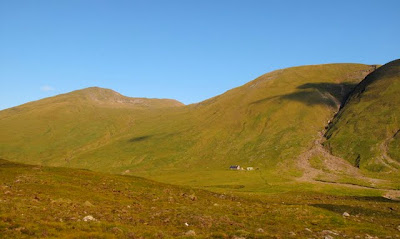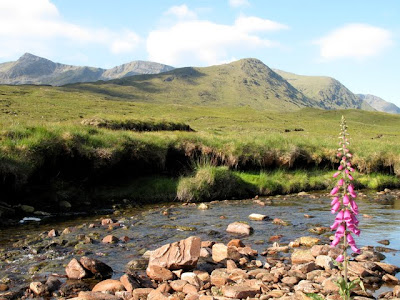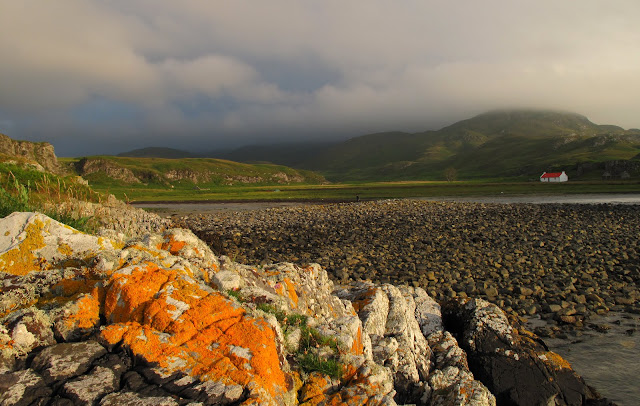There's been plenty outdoor action this summer but no lightweight overnight dogwalks since April, when I tested my one man tent in
Glen Affric. Ever since writing about the
solstice a couple of weeks ago I've been like a coiled spring, possessed by a burning urge to take full advantage of the light nights. What motivated me in particular was a high camp, a chance to spend a night in the sky. The opportunity arose on Saturday night. The forecast was irresistible, cloud-free hills and light winds.
Maoile Lunndaidh, a vast and remote hill to the north of Loch Monar is one that I've had my eye on for a while, having bagged all the surrounding peaks. It is perhaps not the most obvious choice for a quick evening ascent with a dog in the party, the shortest approach to the base of the hill being around 9 km up the Pollan Bhuidhe from Achnashellach, necessitating a mountainbike approach. As I packed I engaged in a constant fight with my lazier side as it tried to dissuade me from venturing out and to tempt me onto the sofa instead.
I left the house just before 2000 and an hour later I was setting off on the track that winds uphill below the great, gully-riven face of Sgurr nan Ceannaichean. The track climbs to a rocky knoll, avoiding the deep gorge of the Allt a'Chonais, before descending into the flat-floored upper glen known as the Pollan Bhuidhe. After the effort of the ascent, still within earshot of the road and railway in Glencarron, the descent brings a liberating feeling of leaving the world behind, of dropping down into a silent netherworld. The name translates, as far as I can tell, as yellow poppy, which seems a strange choice or perhaps an incorrect translation. I love country like this, where the landforms themselves define the route, providing a natural and aesthetically satisfying path through the landscape. To my right the branching of alternative routes jogged memories of hill days past: the paths over Sgurr na Feartaig and up to the Bealach Bearnais, both of which provide fine routes into the great basin in which lie the Bendronaig and Bearnais bothies.
 |
| Camp spot on the summit |
All is quiet in the Pollan Bhuidhe now, but in days gone by many travellers would have passed through, following the
old drove road from Poolewe to Fort Augustus. I followed in their footsteps as far as the peculiar trio of buildings at Glenuaig Lodge: the lodge itself; a sizeable turbine house; a small wooden bothy. The bothy is comparatively luxurious, boasting a bunkbed with mattress, electric light and - probably uniquely - electric heating courtesy of the adjacent hydro scheme. I could feel cabin fever building even in the 20 seconds or so that I spent inside and was glad to strike off up onto the slopes of Maoile Lunndaidh.
 |
| Loch Monar, early morning |
I arrived on the pleasingly flat and grassy summit at half past eleven. The climb had been in daylight and I only just needed my headtorch to erect my tent. Once inside I became acutely conscious of the great mass of the mountain below me. It was a similar sensation to that felt when caving, or in the depths of a coal mine, but in reverse. When one is underground the awareness of such a mass of rock above is oppressive, alarming, claustrophobic. But when the rock is below, there is a liberating and intoxicating feeling of being pushed upwards into the sky and deep into the cosmos beyond.
 |
| View across a mirror-flat Loch Monar to the north Mullardoch Ridge, Pait and the Gead Lochs |
 |
| Glenuaig with Sgurr nan Ceannaichean and Moruisg behind |
 |
| Bidean an Eoin Dearg, Sgurr a'Chaorachain and Sgurr Choinnich from near Glenuaig |
The morning dawned fine and I was pacing around the plateau with my morning coffee shortly after 0600. It was a privilege to wake up not only amid such beauty, but in the heart of a landscape that is loaded with meaning, with stories and with significance through the writings of Iain R Thomson in 'Isolation Shepherd'. If only more corners of this great country had been brought to life through literature to the same extent as have these wild Monar hills.
It has been too long since I last visited this area. The previous occasion could not have been more different, an arduous
winter journey to Maol Bhuidhe.





